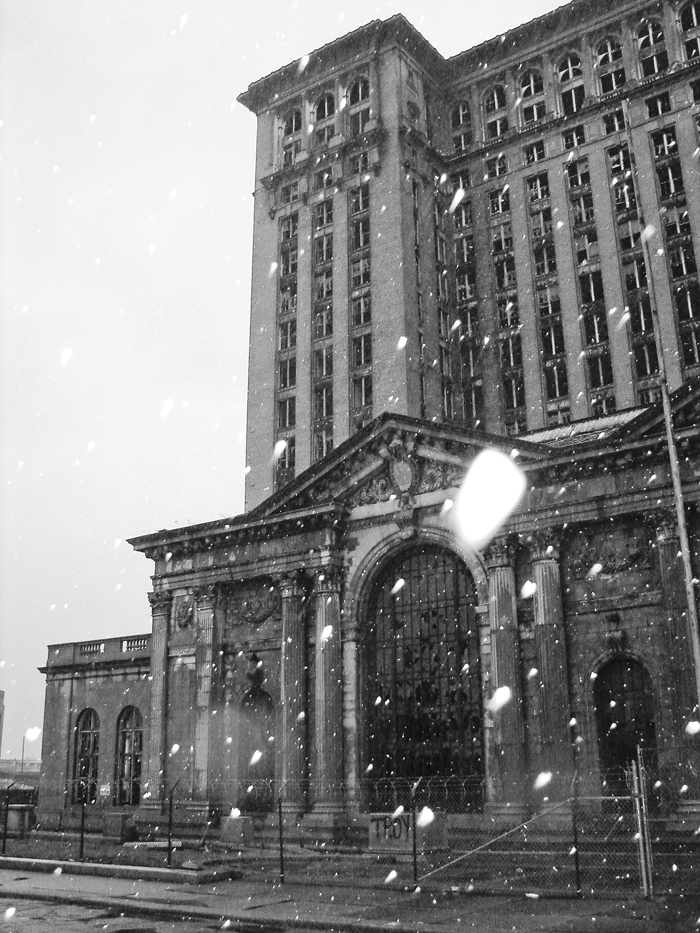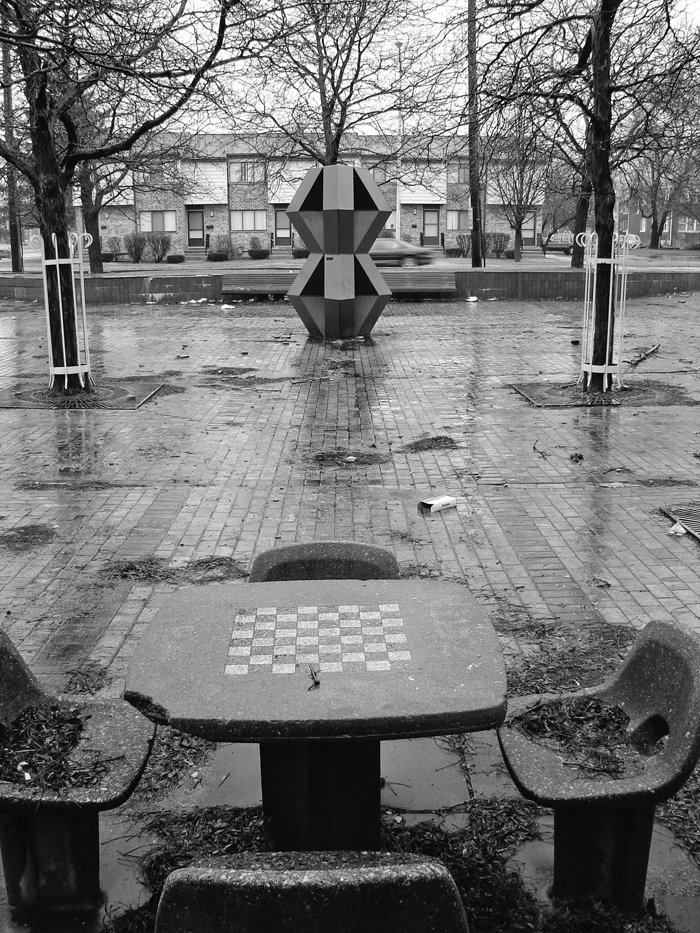In February 2006, Edgar Arceneaux and I visited Detroit in order to research two occurrences from almost forty years ago: the 12th Street Riots of 1967, and the installation of Michael Heizer’s earthwork Dragged Mass Displacement on the lawn of the Detroit Institute of the Arts in 1971. This column aims to put some of our impressions of the place into written form.
From Romulus to River Rouge in a One-Two-Five Smartbus with a broken window. Thousand-foot smokestacks emit blue flames over the roof of a Smart & Final, before a White Castle blots them out. And then farther, up Fort Street to the city center on the edge of the Detroit River, where the Superbowl and the Motown Winter Blast have turned bus routes into a snarled mess. I get out on Lafayette and follow the crowds to Woodward. White, heated pavilions block out the sleet for visitors unused to the Michigan winter. A light, prismatic haze hangs in the air between the black skyscrapers, which makes the street scene into a glittering, endometrial interior — though later my photographs will reveal only a prosaic street fair. When Edgar arrives the following day I take him to this spot, but by that time the blurred, gothic quality is gone; in its place shit-faced seniors grotesquely sing along to “Culo” and “Baby Got Back.”
Woodward is the centermost spoke of six streets that radiate north and west from the city center towards Ferndale and Hamtramck; a conventional urban grid is superimposed on top of it. A third plan, half of a decagonal structure, ripples south from Grand Circus Park towards the water. On a map they have a certain grace — like Lacan’s diagram of the gaze knocked out of true — that persists in experience. Downtown Detroit is built on a complex mirror-geometry, and is full of odd angles and switchbacks. Grand River, one of the spokes of the first plan, hooks sympathetically around the decagon of the third, crosses Woodward, and ends up parallel to Gratiot; any street downtown might suddenly veer off into another orbit.
Metro Detroit is in the midst of an expensive urban revitalization, but much of what we see looks symbolic rather than structural — silver grills over bad teeth. Scaffolding leans gingerly against rotting Victorians in east Woodward, to signify conservation, and great numbers of the somber, vacant skyscrapers are merely boarded up against mischief. In other cases these abandoned structures are simply cavities, empty lots where the rubble of some great structure has been plowed under; Detroit “is a counterpart in the [urban] order to what Vesuvius is in the geographic order: a menacing, hazardous massif…”1 These erasures give the city an almost premodern morphology in some parts, which makes it uncanny when one comes upon the vast boulevards or massive 20th century buildings. “Shadowy structures,” writes Camilo José Vergara, “silhouetted against the sky, loom like huge, undefined forms.”2
Michael Heizer’s Dragged Mass Displacement was installed on the north side of the Detroit Institute of Arts on Woodward over the course of three days in 1971. Heizer’s idea for the work involved dragging an enormous, thirty-ton granite block across the Institute’s north lawn, until its weight began to dig inexorably into the ground, and “an impressive pile of dirt was dug up.”3 His medium, however, refused to cooperate. Even with the help of two D8 Caterpillar tractors and a ten-man crew, and despite the fact the Institute had replaced the lawn with loose dirt two days before, the block refused to sink into the earth. Instead, it slid awkwardly across the prepared surface. “It didn’t tilt, burrow, or dig into the ground, and it didn’t sculpt,” wrote a reporter from the Detroit Free Press; a frustrated Heizer was quoted as saying “We screwed up.”4 The mound of dirt that was supposed to accumulate as the rock was dragged along also failed to materialize, forcing Heizer to shove it into place with two extra bulldozers. The earth mound we see in photographs of the work is not the material result of the stone’s drag, but a simulation of the “impressive pile” the artist had imagined. Another false front.
Even so the work carried a charge. Writing that year, Guggenheim curator Diane Waldman cited the work’s “brutality,” “aggression,” and “abandonment of order for chaos,” negative associations that must have contributed to the removal, and subsequent destruction, of the work by the Institute later that year. One has to wonder what would have happened if, as Heizer hoped, Dragged Mass had remained on the lawn. How would it have spoken to the urban catastrophe of the last three decades? As Waldman wrote, “Do we accept the familiar… or do we recognize that the violation of what we know touches, of necessity, upon the origins of creativity?”5 In 1971 the Detroit Institute accepted the familiar and ameliorative. Now a Tony Smith sculpture, Gracehoper (1961), hunkers gracelessly over the soggy north lawn.
The Detroit Public Library is an immense edifice located across from the Detroit Institute. When I visit, the only women I notice are librarians; the patrons are all men, inattentively reading books plucked from some unlikely section: Science and Industry, a book on the Serengeti. I guess that they are cruising each other — a sure sign of a semi-abandoned place. I climb upstairs to the art section, a thin set of shelves in an immense gallery. This collection reveals well-defined strata of acquisitions: gigantic, aging catalogs bought during the expansion in the mid-60s pay giddy tribute to Frank Stella and Kenneth Noland; another clutch of books from the early 1990s marks a dutiful investment in Faith Ringgold and African crafts. Leave the arts room and you’re in another place entirely, a dim, colossal no- zone, with painted workers winking at you from the gloomy WPA-era mural dozens of feet above your head.

Edgar Arceneaux & Julian Myers, Michigan Station, Detroit, 2006. Digital photograph.
Edgar and I spend one morning marking locations on a map where people were killed during the “race riot” in 1967. Krikor Messerlian, an old Armenian who tried to defend his shoe repair shop with a ceremonial saber, died on Linwood near 12th. Helen Hall, a fiftyish woman on a business trip, caught a National Guardsman’s bullet in her hotel room on John C. Lodge. Four- year-old Tanya Blanding was killed by another Guardsman when a relative lit a cigarette in her home at 1756 Euclid—they thought the flash of his lighter was a sniper’s rifle. Sheren George, an exotic dancer and mother of two, died in the passenger seat of her car at Woodward near Melbourne. There are forty-three of these sites, which means the map quickly becomes a hard-to-read clot of notations.
When, on Saturday morning, we begin driving to the various places, we realize that the city in which Sheren George and Tanya Blanding lived no longer exists. There is no 1756 Euclid, no ruin, no sad reminder, no tragic tale, no specificity, no place at all. Were these places burned down or plowed under? We almost admire Detroit’s aptitude for protean realignment—its passion for erasure, its unsentimentality, which the author Jeff Byles has called “Detroit’s great bonfire of unbuilding.”6 When we find the site where the riots began, at an after-hours drinking establishment at 12th (now Rosa Parks) and Clairmount, we find a crumbling plaza, layered in decaying leaves and loose tiles—stone seats for playing chess, a piece of “public art”—metastases of erasure, a different kind of modernism, Beckett instead of Jugendstil. Edgar throws some clay tiles in the trunk, and asks me to remind him they’re there. (Of course, I forget.)

Edgar Arceneaux & Julian Myers, Clairmount St. & Rosa Parks Blvd., Detroit, 2006. Digital photograph.
“Was it a riot or a guerrilla uprising?” wrote Jeffrey Eugenides in 2002, in his novel set in the period. “Let me answer that question with other questions. After the riot was over, were, or were there not, caches of weapons found all over the neighborhood? And were the weapons, or were they not, AK-47s and machine guns? And why had General Throckmorton deployed his tanks on the East Side, miles from the rioting? Was that the kind of thing you did to subdue an unorganized gang of snipers? Or was it more in keeping with military strategy? …[W]hen it finally happened,” he concludes, “The revolution wasn’t televised. On TV they called it only a riot.”7
Detroiters enjoyed telling us that we had picked an odd time to come to Detroit to do our research, what with the Superbowl and everything. But we thought it a natural choice. For what is a football game but a riot on a grid, a riot with rules? The revolution televised. A riot planned by the city and monitored by the police, who stand nearby smiling as they finger their pistols. A riot’s mirror image, a riot in reverse.
Julian Myers is an art historian and critic living in San Francisco. He teaches at California College of the Arts. He thanks Susanne Hilberry Gallery, Detroit Institute of the Arts, and Artpace San Antonio for their support.
